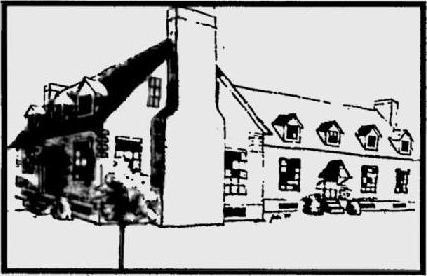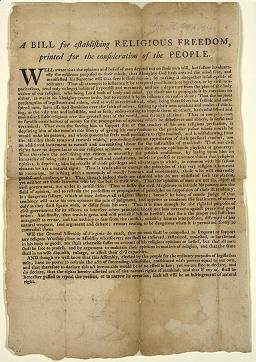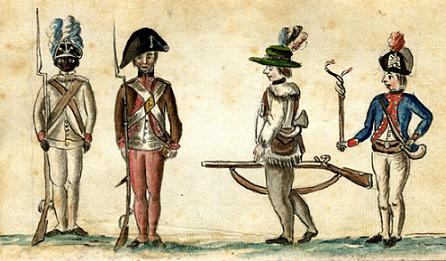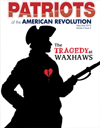THE Announcement
As promised...today it is with great anticipation that I can finally announce some of the details about my next book project. This will be my 7th title, and easily the most ambitious, challenging, and scholarly to date. It will also require the most research and will likely not see shelves until 2012 (at the earliest). I have made several contacts recently which have directed me to some tremendous primary sources and archived reference that has yet to see the light of day. As a result, a rarely discussed aspect of a very famous life can now be shared.
The working title is Faith, Freedom, and Fallacy: Thomas Jefferson and the Virginia Statute of Religious Freedom. This book will present: Thomas Jefferson’s time at Fredericksburg in 1777, his meeting there at Weedon’s Tavern, in which he agreed to author the Virginia Statute of Religious Freedom, the story surrounding the writing of it, why Jefferson took so much pride in its completion, and how the results are debated and commemorated to this day.
This subject has not been examined definitively in any single study –at least from the angle at which I am pursuing it. In 1998, Cambridge Studies in Religion and American Public Life Series included a book titled The Virginia Statute for Religious Freedom: Its Evolution and Consequences in American History, but as this book looks at the statute from more of a political and sociological perspective, my study will (hopefully) be more intimate and include unpublished material on Jefferson’s time here in Fredericksburg.
Yes, there is a tentative publisher, although I have not signed a formal agreement yet. There is some discussion going on over the length of the manuscript. I am shooting for a longer piece than any of my previous books.
I will be working with sources from the Thomas Jefferson Foundation at Monticello and Central Rappahannock Regional Library, as well as some private materials from personal collections. I am waiting until I give my address on Jackson’s Valley Campaign at Lexington in June, and the release of our documentary on Richard Kirkland at the end of that month before directing all of my energies into this manuscript.
I have begun the process of acquiring data and can’t wait to see where this journey goes. I stated back in 2008 that my next goal was to pen something significant on Thomas Jefferson. Since then I have read four outstanding books on the man all of which I could never top. I just needed to find an original topic that would allow me to present something meaningful and interesting. I now have my subject and my sources. Stay tuned.
Racism and Recruiting
ABOVE: Four Soldiers (Jean Baptiste Antoine de Verger, circa 1781) From left to
right, a black soldier of the 1st Rhode Island Regiment, a New England militiaman,
a frontier rifleman, and a French officer. (Source: Brown University)
Over the last few months I have written a few pieces, some for magazines and others for this blog, dealing with the sensitive issue of race in Colonial America. One feature for PAR magazine presented the way that slavery is now being interpreted at the new Monticello Visitor’s Center. A recent post dealt with George Washington's slaves and their emancipation according to his will. The subject of racial conflict, albeit uncomfortable at times, has become an interesting topic to say the least. I have examined it briefly in my previous work, when presenting the history of the split between the white and black members of the Fredericksburg Baptist Church prior to the Civil War, but never to the extent that I am researching it now.
I am nearing the completion of an outstanding study by Edward G. Lengel titled General George Washington: A Military Life. What I really enjoy about this book is the unbiased and balanced presentation that the author, a military historian and professor from UVA, has achieved. Readers are presented with an excellent portrait of a brilliant, but not infallible commander. One chapter near the end of the book speaks frankly to Washington’s prejudice and ardent refusal to enlist and arm African-Americans.
Lendel’s version of this subject is perhaps the most unsympathetic, yet fairest that I have read. His take on the matter has provoked much thought in regards to the general that I was familiar with. I now see a distinct difference between the Washington at war, initially refusing to diversify his forces despite a tremendous lack of manpower, and the one we see conflicted over the institution of slavery while freeing his servants in death. Much like Lincoln, Washington evolved in his attitudes toward minorities over the course of his life.
This is understandable, but what I can’t understand is the manner in which an otherwise stellar commander would compromise his troops (and cause) due to a racial bias. In fact, at this point in the conflict, why would anyone, soldier or politician, racist or not, restrict the addition of more men in the field? Washington was not the only one guilty of discrimination. Congress echoed his sentiments and even went further in their own restrictions.
Unlike the American Civil War, in which preserving the institution of slavery was a major factor behind secession, the Revolutionary War was a fight for independence from England. So while I can easily understand why the Confederacy would refrain from arming slaves, why wouldn’t the Continental Congress call for every able-bodied male to fight against the most well equipped and trained army in the world?
Simply put, Washington and his peers were shooting themselves in the foot. Regardless of one’s personal feelings on equality, why wouldn’t they take anyone who wished to serve? This, in my opinion, speaks to how racism and the institution of slavery held a tight grip on society in order to maintain the status quo.
As the supreme commander of a fledgling army and a Virginia planter, Washington was obviously put in a very complicated position. If he armed blacks (freed or slave), he risked infuriating his fellow slaveholders. If he refused, his forces would continue to dwindle. What this future politician did was hold out as long as he could and allow others to take steps toward an integrated army. This absolved him of responsibility either way and preserved his favor in the eyes of both sides of the argument. It was brilliant.
Still, I find it difficult to comprehend how a man whose forces were in such desperate need of reinforcements could refuse volunteers. (The notion of arming blacks was only considered after the British Army began padding their own ranks with both African and Native Americans.) Why? Was Washington cognizant of the political-ramifications of integrating the army and simply protecting his own future? Or was his racial prejudice at the time too stubborn to compromise? I just don’t know, but I think it would make for an interesting discussion.
What are your thoughts on this subject? What do you think were General George Washington's motivations for preventing blacks from serving under his command as long as he did? Were they personal or professional? Political? Military? Racist? Or all of the above?
Rather than simply extracting data points from Lengel’s book, I am quoting a portion of it here in it’s entirety with hopes that it may generate some feedback. I am also going to email the professor with an open invitation to comment and/or guest post on this subject.
Excerpt taken from General George Washington: A Military Life by Edward G. Lengel (Random House Trade Paperbacks, January, 2007) BUY THE BOOK:
[Quote] Social considerations-or, to put it more acutely, prejudice-also prevented Washington from welcoming blacks into the Continental Army; but his attitudes on this subject shifted over time. In July 1775 at Cambridge, Massachusetts, he had expressed consternation at the number of “Boys, Deserters, and Negroes” in the ranks. At his instigation the adjunct general promptly directed recruiting officers not to enlist “any deserter from the Ministerial army, nor any stroller, negro, or vagabond.” Three months later, when Washington asked his officers whether blacks already in the army should be reenlisted, they “agreed unanimously to reject all Slaves, & by a great Majority to reject Negroes altogether.” The commander-in-chief agreed, and on November 12th he ordered that “neither Negroes, Boys unable to bare Arms, nor old men unfit to endure the fatigues of campaign, are to be enlisted.” Blacks, the directive implied, were just as “unfit” to serve as boys or old men.
Washington issued these orders unaware that days before, on November 7th, royal governor Lord Dunmore of Virginia had declared his willingness to grant freedom to slaves and indentured servants who joined the British standard. This socially subversive proclamation outraged Virginia slaveholders. Writing to Virginia delegate Richard Henry Lee on December 26th, Washington denounced Dunmore’s “diabolical schemes” and rumbled that “if My Dear Sir that Man is not crushed before Spring, he will become the most formidable Enemy America has-his strength will Increase as a Snow ball by Rolling; and faster, if some expedient cannot be hit upon to convince the Slaves and Servants of the Impotency of His designs.” Washington’s feeble “expedient” amounted to allowing recruiting officers to enroll new volunteers who were free blacks, but not slaves. Congress promptly undercut him by resolving only to enlist “the free negroes who have served faithfully in the army at Cambridge,” but not to accept any new applicants.
[The chapter then goes on to describe the efforts by other officers to start integrated units including the consolidated 1st- and 2nd Rhode Island Battalion which was ¾ black. It then presents the tireless petitioning by one of the commander-in-chief’s aides, John Laurens, to arm freed slaves. Washington remained steadfast.]
…In any event Washington offered no public support for the proposal. And a year later, as Laurens still struggled to make his dream a reality, Washington dismissed it as infeasible. The idea “has never employed much of my thoughts,” he admitted in a March 20, 1779, letter to Henry Laurens, but “the policy of arming Slaves in my opinion a moot point, unless the enemy set the example, for should we begin to form Battalions of them, I have not the smallest doubt…of their following in it, and justifying the measure upon our own ground. The upshot then must be who can arm fastest-and where are our Arms?” The last thing America needed was for the British to put muskets in the hands of thousands of ex-slaves. “Besides,” Washington continued, “I am not clear that a discrimination will not render Slavery more Irksome to those who remain in it-Most of the good and evil things of this life are judged of by comparison and I fear Comparison in this case will be productive of much discontent in those who are held in servitude.” In short, he seems to have feared that arming blacks on a large scale would spur an exodus from the plantations that might destroy the institution of slavery altogether. And that was something he feared to contemplate. [End quote]
Despite these issues African-Americans did serve in the Continental Army with distinction (only about 6% of troops were black), and much like the Loyalists of New Brunswick, they are now receiving recognition. Colonial Williamsburg’s website features an extraordinary paper by Noel B. Poirier titled Brave and Gallant Soldiers: African Americans and the Continental Army.
VAFB speech
Today I received a video of the address that I gave at the Virginia Farm Bureau Women’s Conference. I would like to thank Sherri McKinney, Sr. Producer at the VAFB, for shooting the piece. This 25-min. speech titled “Mary Ball Washington: The Mother of the Father of Our Country” has since then evolved into a 3,000+-word feature that will be running in the July/August issue of Patriots of the American Revolution, as well as a 40-min. presentation that I will be giving in October to the Stafford County Historical Society. This video was shot at the Fredericksburg Hospitality House, on Sunday, March 21, at 7:30 am. I was asked to provide a brief talk that would support the theme of “Past is Present,” and deliver it as a devotional in lieu of the church service that the 350+ attendees would be missing. I didn't have much time to prepare, but I'm fairly happy with how it turned out. Enjoy.
Mary Ball Washington (Part 1) from Michael Aubrecht on Vimeo.
Mary Ball Washington (Part 2) from Michael Aubrecht on Vimeo.
Hero and Host

ABOVE: A sketch of Weedon's Tavern based on an insurance paper description.
(Sketch by Philip K. Brown, Courtesy of Paula S. Felder, The Free Lance-Star, December 1999)
CORRECTION (Posted 5/1/10): Historian Marian McCabe was kind enough to identify some incorrect data in my post on Weedon’s Tavern and offer the following insights: I noticed that in the section of your blog on Weedon’s Tavern you stated that it was originally built as a home by Charles Washington. Charles Washington’s home, located at 1306 Caroline Street between Fauquier and Hawke Streets, did indeed become a tavern, under a different owner at a later date. In 1792, the house was leased to John Frazier, who named in the Golden Eagle Tavern. In 1821 it was renamed the Rising Sun Tavern by a new tavern operator. In 1827 the building once again became a private residence. It is now owned by Preservation Virginia and is open to the public as the Rising Sun Tavern, a restored 18th century tavern. Weedon’s Tavern (originally Gordon’s) was located at or very near the intersection of Caroline and Amelia Streets – as you noted, “nearly opposite” the town hall and public market, which were located between Caroline and Princess Anne and George and Hanover Streets. Although he had nothing to do with the building itself, Charles Washington was a partner in a butchering business run by George Weedon. Thank you Marian.
A few weeks ago I briefly mentioned a Fredericksburg establishment known as Weedon’s Tavern. This is where Thomas Jefferson met with his political contemporaries in 1777 and agreed to author a bill for spiritual liberties in America. The committee present at Weedon’s was composed of George Mason, George Wythe, Edmund Pendleton and Thomas Ludwell Lee. Jefferson’s declaration of tolerance that followed resulted in the Virginia Statute of Religious Freedom. This mandate initiated the separation of church and state and is still a part of the Old Dominion’s Constitution. Weedon’s Tavern therefore played a small role in one of the most politically significant events in our nation’s history.
The original structure was built as a home by Charles Washington in 1760 and was later converted into a tavern. It was owned by a subordinate of General George Washington’s named George Weedon, who later became the mayor of Fredericksburg. This was the third inn under Weedon’s management as he had previously run Gordon’s Tavern and the Jockey Races. These colonial hot-spots became regular gathering places for both freemasons and private gentlemen’s clubs. According to a 1999 article by Paula S. Felder in The Free Lance-Star, Weedon’s ledgers (1773-1775) contain over 500 accounts that provide “an invaluable glimpse of people and customs in Fredericksburg during the last years of the colonial era.”
As an experienced military officer, Weedon had served as a Brigadier General in the Continental Army and later in the Virginia Militia. Second in command (and brother-in-law) to Fredericksburg patriot High Mercer, he was present at Trenton, Brandywine, Germantown, Valley Forge, Delaware Crossing and the Yorktown Campaign. Prior to the War for Independence, he served as a Lieutenant under George Washington during the French and Indian War. His service to General Washington however, did not end in the field. In the Diaries of George Washington (Vol. II. 1766-70) the author recorded that:
George Weedon kept a “large and commodious” tavern on the main street of Fredericksburg (now Caroline Street) “nearly opposite” the town hall and public market. Frequented “by the first gentlemen” of Virginia and “neighboring colonies,” it contained “a well accustomed billiard room” and was the place where local horse races were arranged…His fellow Freemasons sometimes adjourned there for food and entertainment after meeting at the town hall…It was a common practice among Virginia gentlemen of this time, when dining or supping at a tavern, to do so in groups either at a private table or, at a large tavern like Weedon’s, in a private room. They would be served as a unit by the innkeeper and then would club for the cost of the food, drink, and room; that is, they would divide the total bill equally. On this evening GW [referring to George Washington] paid 2s. 6d. as his share of the club and lost 15. 6d. at cards.
Despite his post-war popularity as an inn-keeper, not all who had gone off to war with George Weedon held him in the same regards as General Washington. Some of his peers felt him to be far too cautious and demure on the battlefield. This included military equals like the Armand Louis de Gontaut, Duc de Lauzun (later duc de Biron), a French soldier and politician, known for the part he played in the American War of Independence and the French Revolutionary Wars. In The Duc de Lauzun and his Legion, Rochambeau’s most troublesome, colorful soldiers, Robert A. Selig recalls how Lauzun’s memoirs accused Weedon to be at times, far too passive on the battlefield:
Lauzun’s Legion left Lebanon on June 21 and reached White Plains, New York, in early July, But the proposed siege of New York City was too much even for the combined Franco-American army. News of the departure of Admiral de Grasse’s fleet for the Chesapeake Bay caused a change in plans. On August 18, the armies began a march for Virginia. By August 30, the legionnaires were resting at Somerset Court House, and by September 8 they had reached Head of Elk, Maryland.
Here Lauzun and his infantry, 270 men, embarked on boats for the journey down the Chesapeake. The hussars under Vicomte Rene Marie de Darrot, 250 men strong, forded the Susquehanna River at Bald Friar’s Ferry, and advanced south by Baltimore, Georgetown, and Fredericksburg. They crossed the Rappahannock River two miles above Falmouth, and rode on to Williamsburg. There the hussars received orders to reenforce the 1,200 or so militia under Brigadier General George Weedon encamped at Gloucester Courthouse on the north side of the York, where they arrived on the 24th.
Lauzun said in his memoirs that on the previous day a distressed Washington had informed him that “Lord Cornwallis had sent all his cavalry and a considerable body of troops to Gloucester, opposite York,” where they were “watched by a corps of three thousand militiamen under the continental Brigadier-General Weedon.” Lauzun considered Weedon, his senior, “a good enough soldier, but one who hated war, in which he had never wished to engage, and went in deadly fear of coming under fire.”
The commander-in-chief suggested, Lauzun said, that he would tell Weedon that Weedon could have “all the honours” of war but forbid him “to interfere in any way” with Lauzun. Lauzun rejected the arrangement. Once his infantry had disembarked ahead of Rochambeau’s main army near Jamestown on the 23rd, Lauzun set out for Gloucester, where he joined his cavalry on the 28th.
He was determined on “getting on excellently” with his American counterpart. Lauzun could be charming. Rochambeau once described him privately as the “most amiable man in France.” But he also thought that Lauzun was “often the most foolish...who never had enough force of character to be successful.” Weedon, an innkeeper from Fredericksburg who had seen battle more than once, may have been “the best fellow in the world,” whose “one desire was not to interfere in anything.” But he had his pride and saw no reason to defer to a boisterous French aristocrat.
Weedon may have been afraid of the British, but he was not afraid of Lauzun.








 Check out the
Check out the